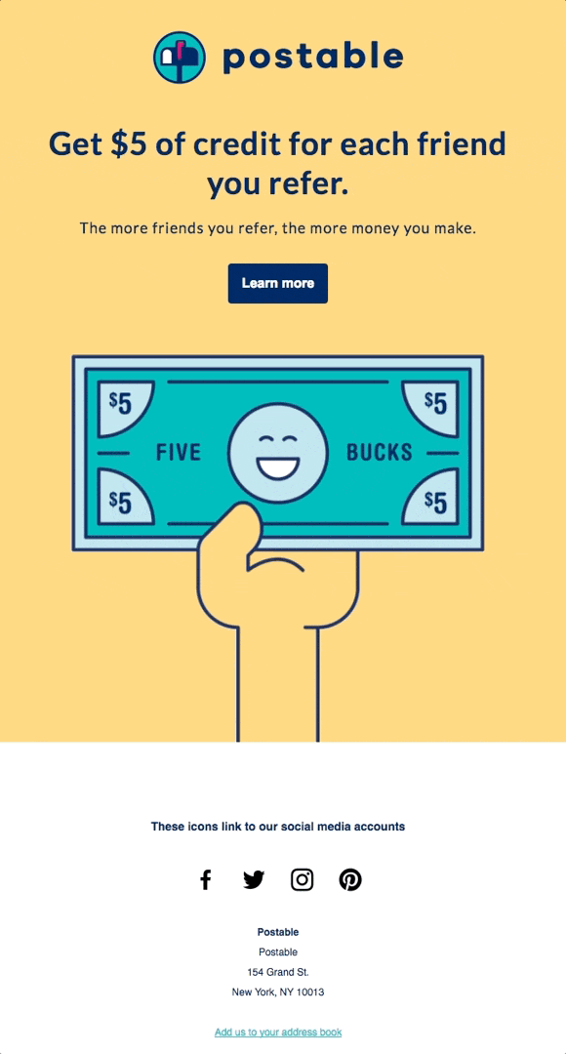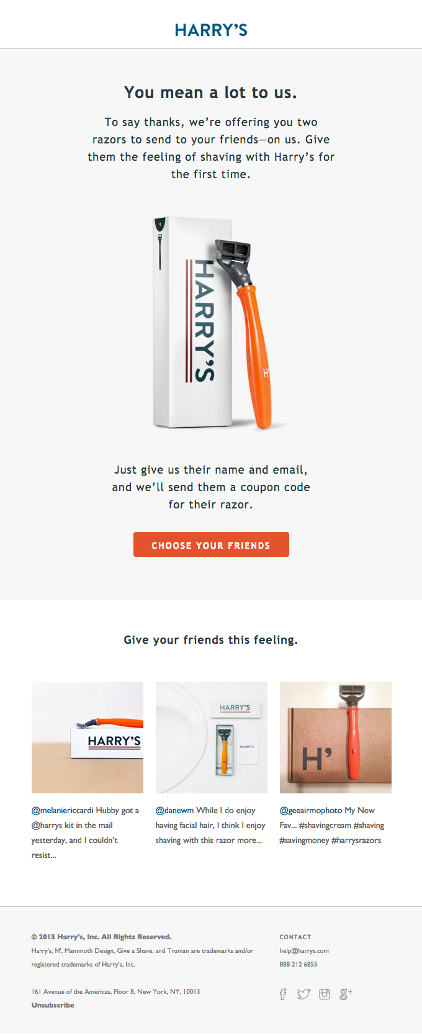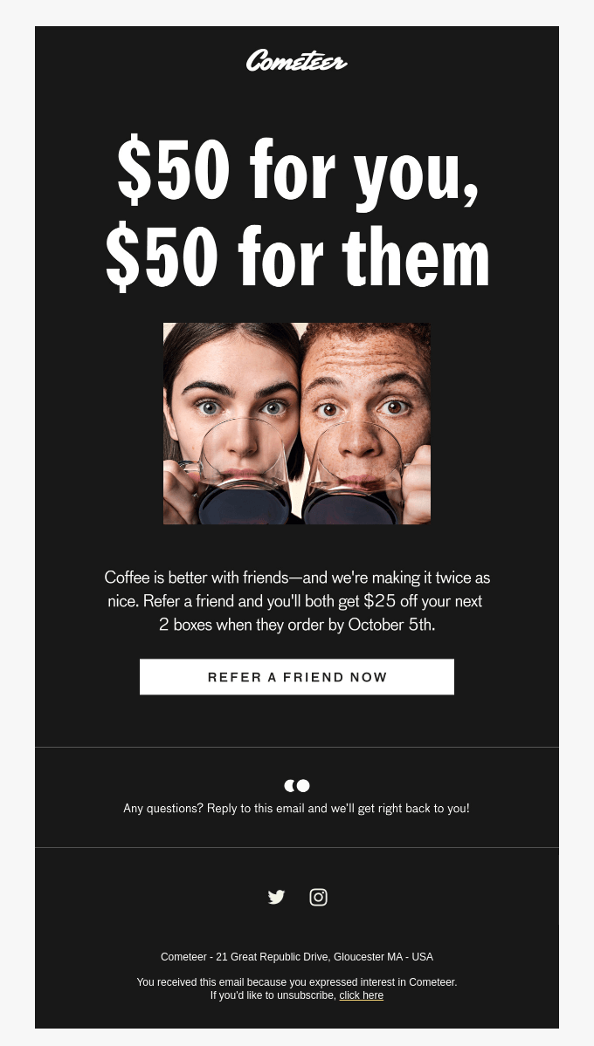Have you ever bought a product or gone to a store after a relative or friend had recommended it? You most likely have, and that is totally normal!
We tend to trust the reviews and recommendations of those we know, thus making both these great marketing tools for businesses of all sizes.
A marketing strategy that is quite similar to reviews and recommendations in that it relies on word-of-mouth marketing and the endorsement by current customers to acquire new ones, is referral email marketing. And in this article, we analyze in detail what this is and how it works.
What is referral email marketing?
Referral email marketing entails using emails to encourage your existing customers (called referees) to bring new customers (referrals) to the business. Typically, such emails present some kind of bonus to the referee for inviting a referral as well as a starting reward for the referral.
Need a real-life example? Okay, let’s imagine you have an app for learning English. It’s good but has a small user base as you’ve only recently entered the market. To expand this user base, you might want to launch a referral email marketing program.
The way this program would work is by giving existing users free 1-month-long access to your premium account for each invited user. To the new users that join, you can give free limited access to some premium features but not the full account.
By doing this, you get new users and thank the existing ones for helping you expand your user base.
Benefits of referral email marketing
The effectiveness of referral email marketing is probably the top reason for its popularity.
Attesting to this effectiveness are the referral marketing statistics presented by FinancesOnline, which state:
- People who hear about a business through referrals convert 30% more than people who hear about a business through other marketing means;
- The lifetime value of referral leads is 16% higher than the lifetime value of other lead types;
- 92% of consumers tend to trust the recommendations or referrals of people they know personally;
- 86% of businesses with structured referral programs have experienced revenue growth within a two-year period;
- 69% of customers who had a positive experience with a company would recommend it to other people.
Disadvantages of referral email marketing
Quite an impressive list of benefits, right? But what about the disadvantages?
Well, as there is nothing perfect in this world, referral email marketing has its faults as well, some of which are:
- You cannot control the type of customers/users your referees bring – People from different age groups, with ranging social statuses and levels of financial wealth, might be brought to you through your referral program, and many may not match your target customer profile.
- You cannot control customer/user base growth – After launching a referral email marketing campaign, the number of new customers/users coming your way will depend on the effort and effectiveness of your referees. Some will be able to bring just one friend, while others might bring their entire family of 5. That being said, you should not count on stable customer/user base growth with this marketing strategy.
- You should always give a generous reward for each referral – If the reward offered in your referral email marketing program is underwhelming, you simply will not be able to gain the interest of potential referees.
- You must already have a popular product – No matter how much effort your referees put in or how high your reward is, if the product/service you are selling is not that good and you have very few existing customers/users, then there is no point in talking about referrals.
Types of referral email marketing messages
Okay, so you’re sold on the idea of referral email marketing. Great! But do you know what types of emails you’ll need to create for your campaign?
A referral email marketing campaign consists of several types of emails, each belonging to a specific referral marketing stage. These types are:
Invitation emails
In any referral email marketing campaign, the initial email outlining exactly what your existing and new customers can expect from the referral program is the most important one.
This email should explain your program incentives as well as how everything works. So before you send it, make sure the benefits of the program are attractive, the rules are crystal clear, and the fine print explaining the nuances isn’t confusing. This will be critical for program success and for spreading the word about it.
Notification emails
To spark up some excitement but also notify the referee that they are about to be rewarded, you can send notification emails once a referral has made a purchase or completed a different desired action.
Thank you emails
Once a referral has been made, the next step is to say “Thank you” and give the referee their well-deserved rewards through email.
Within the same email, it’s good practice to encourage the referee to keep inviting new customers/users by promising a higher reward for the next referral or just reminding them how easy it is to benefit from your program.
Reminder emails
Old and potential new referees might need to be reminded of what they can receive/have received with your referral program.
With a reminder email, you can motivate them to take your referral program more seriously and get their first reward, or if they have successfully participated in the past, get back to spreading the word and reaping the rewards.
Examples of referral email marketing from famous brands
When deciding if a marketing strategy is right for you, there is nothing as convincing as seeing famous brands from your and other industries using it themselves.
In terms of referral email marketing, many well-known brands use this email marketing strategy.
Here are some examples:
Airbnb
Airbnb, the well-known website for listing and finding private short-term rentals around the world, has a referral program that gives $30 of travel credit to each new Airbnb user and $30 to the referee once their friend/family member takes their first trip.
The referral program email has a simple yet creative design featuring company colors, a short description of the program, and an eye-catching CTA.
Uber
Referral programs are a fairly common feature in mobility as a service/ride-hailing platforms, and Uber is no exception.
The company sends promotional codes for trips in their emails which can be shared with friends by inviting them to the application. In return, the person who shared the code gets a free ride.
Their referral marketing email design is quite simple, perhaps because they have opted for promotional codes instead of invitations.
The promotional code immediately catches your eye, after which you instinctively want to see how it works.
On top of that, Uber provides a convenient way of sharing promotional codes on social networks using attractive buttons in the design.
Postable
Postable is a company that sends custom cards on various holidays and for various events.
Their referral marketing email has a nice illustration explaining the purpose of the email – to introduce a program for earning money by inviting friends.
In addition, Postable decided not to overload the email with unnecessary text and instead offers more details about the referral program on an external page accessible by pressing the “Learn more” button.
If your referral program has many nuances, this is the approach you should follow.
Harry’s
Harry’s, the manufacturer of grooming products for men, also uses referral email marketing.
The way their campaign works is by asking customers to submit the names and emails of a few friends, so the company can send them promotional codes for razors from the company. Pretty smart move, in my opinion.
Cometeer
There is nothing better than a cup of aromatic coffee in the morning. Especially if you have someone to share it with. Cometeer probably had this thought when creating their referral email marketing campaign.
In the campaign, they ask customers to recommend their coffee to their friends in exchange for a $25 discount on their next purchase for both the referee and referral.
Design-wise, Cometeer decided to go big with fonts and a summary of the entire referral program on a black background. Beautiful and eye-catching!
The entire email is done in dark colors with white text so that nothing distracts from the referral program. What’s more, an image of two friends enjoying coffee is there to add a friendship element.
Steps for creating a referral email marketing campaign
Whew! We have talked about a lot of things thus far.
But now it’s time for some practical information on how to create and run a referral email marketing campaign.
During this process, you’ll have to cover a few steps:
Step #1 – Come up with referral program incentives
To make your program enticing, you have to put some thought into its incentives.
As a rule of thumb, you can pick between two types of incentives:
- Cash rewards – have a set monetary value, making them the simplest form of reward.
- Non-cash rewards – a unique form of incentive in that it has no set monetary value and is often in the form of early access, loyalty points, promo codes, gifts, and more.
Along with incentive type, you also need to decide on the incentive structure by picking between the following:
- A single incentive structure – rewards only the referee.
- A dual incentive structure – rewards both the referee and the referral.
Step #2 – Create your referral emails
Your referral email design should be different from your other email designs but still contain the core aspects of your brand, which include colors, fonts, visuals, logos, and so on. Graphic design platforms typically include various marketing templates, logo maker feature and modern fonts, which can help you slightly adjust email design while keeping the brand identity.
When it comes to content, referral emails are quite simple and usually have just a bit of text intended to explain the rules of the referral program, what reward participants will receive, and an “Invite Friends” CTA button.
Step #3 – Tracking and rewarding
So, you designed your emails and sent them out. Now it’s time to track the number of referees and referrals acquired and give out rewards where they are due.
To do this, you must have a platform that synchronizes with your marketing solution, thus allowing you to issue rewards quickly and without delay, count the number of referrals, and also keep in touch with all participants of the referral program.
Step #4 – Test and Improve
The first iteration of your referral email marketing campaign might be working, but sending it out is not where you stop its development.
What now awaits is the long task of testing and improving the campaign so you find the golden mean that will ensure its maximum effectiveness.
So, experiment with email designs, rewards, as well as other referral program aspects and test, test, and test again. Only this way will you be able to understand what works best for you and why.
Tips for running successful referral email marketing campaigns
Now that we have gone over some impressive referral email marketing statistics as well as examples of how popular brands are using the strategy, it’s time to address the question most of you are likely asking yourself, “How can I make my referral email marketing campaign as good and as effective?”
While that question will largely depend on your target audience as well as the product/service you are offering, following these tips might help:
Tip #1 – Come up with a good email subject line
Subject lines are the first thing any recipient sees, making them as important as first impressions.
According to surveys, 33% of email recipients open emails because of catchy subject lines. So when creating a referral marketing email, it is worth trying to come up with a subject line that will highly encourage the recipient to open the email.
Here is how some well-known companies tackle this task in case you need inspiration:
- Get free Bitcoin when you refer a friend — Coinbase;
- Welcome to Hylo. Here’s your referral code. — HYLO;
- Exclusive: Refer 2 friends. Get 1 free Lumina webcam. — Lumina;
- Spread the Love (And Get PAID💰) — MeUndies;
- Refer your friends and get $$$ — Postable;
- Want 30 days of free Premium access? Refer a friend 💙 — Busuu;
- Two razors for your friends (on us) — Harry’s;
- Earn up to $200 in rewards when you share 🤝 — Equal Parts;
- Be a good friend, get $15 — Italic;
- Get $5 off for every friend you refer. — Maude.
Referral marketing emails should include a single call to action, that way, the recipient knows right off the bat what action to take.
So, when in the email design stage, make sure things don’t look spammy, and there aren’t too many CTA buttons the recipient could get distracted by.
On top of that, the call to action should allow the referee to immediately recommend your product/service and reduce as much as possible the time from opening your email to sending a recommendation.
Tip #3 – Have a brand-consistent design
Your email design should match your brand voice and design guidelines. In other words, the colors, fonts, graphic elements, etc., used in it should be recognizable and familiar to recipients.
If you skip on sticking to a look your brand is known for, recipients might doubt the authenticity of your message and will thus be afraid to give you their data and continue the referral chain process.
Tip #4 – Have clear referral program terms and conditions
Like for any other promotional program, the terms and conditions for your referral program must be clear and easily accessible to the recipient of the email.
So, for example, if bonuses for the referee come only after 3 referral purchases, indicate this immediately in the initial email. Otherwise, you risk damaging your reputation and losing both the referee and potential referrals.
Tip #5 – Make your offer personalized
Personalization is a powerful weapon in the hands of marketers, and personalized emails have an 82% higher open rate than generic emails.
Why so? Well, recipients don’t want to open generic emails. Instead, they want a more personalized experience and to feel valued by a company.
You can implement personalization in the subject line, and the email body, or you can get creative and offer a personalized referral code based on the recipient’s birthday, for instance.
Remember, you are only limited by your imagination when it comes to personalization.
Wrapping up
Referral email marketing is a great and easy way to expand your customer/user base, as the main job of finding and attracting new customers/users falls on the shoulders of existing ones.
All you need to do is encourage customers/users to recommend you to friends by coming up with a worthy reward, following the other tips and tricks we mentioned in this article, and once you get your precious referrals, sending the reward to each referee. Easy!









